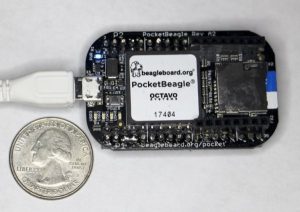The PocketBeagle is a tiny but powerful inexpensive key-fob-sized open source Linux computer. It has 44 digital I/O pins, 8 analog inputs, and supports multiple serial I/O protocols, making it very useful as a controller. In addition, its processor includes two 200-MHz microcontrollers that allow you to implement low-latency, real-time functions while still having the capabilities of a Linux system This article discusses my experience trying out different features of the PocketBeagle, along with some technical details.
You may be familiar with the BeagleBone, a credit-card sized computer. The PocketBeagle is very similar to the BeagleBone, but smaller and cheaper. Both systems use TI’s 1GHz “Sitara” ARM Cortex-A8 processor, but the PocketBeagle’s I/O is stripped-down with 72 header pins compared to 92 on the BeagleBone. The PocketBeagle doesn’t have the BeagleBone’s 4GB on-board flash; all storage is on a micro-SD card. The BeagleBone’s Ethernet and HDMI ports are also dropped.
The PocketBeagle uses an interesting technology to achieve its compact size—it is built around a System-In-Package (SIP) device that has multiple dies and components in one package (see diagram below). The Octavo Systems OSD3358-SM combines the TI 3358 Sitara processor, 512MB of RAM, power management and EEPROM. 1 In the photo above, this package has a white label and dominates the circuit board.
Initializing the SD card
To use the PocketBeagle, you must write a Linux file system to a micro-SD card. The easiest way to do this is to download an image, write it to the SD card from your computer, and then pop the SD card into the PocketBeagle. Details are in the footnotes.2
You can also compile a kernel from scratch, set up U-boot, and build a file system on the SD card. the PocketBeagle. There’s a bunch of information on this process at Digikey’s PocketBeagle getting started page. This is the way to go if you want flexibility, but it’s overkill if you just want to try out the PocketBeagle.
Starting up the PocketBeagle
Unlike the BeagleBone, which supports a keyboard and an HDMI output, the PocketBeagle is designed as a “headless” device that you ssh into. You can plug the PocketBeagle into your computer’s USB port, and the PocketBeagle should appear as a network device: 192.168.6.2 on Mac/Linux and 192.168.7.2 on Windows (details). You should also see a flash-drive style file system appear on your computer under the name “BEAGLEBONE”. If the PocketBeagle has the default Debian OS3, you can log in with:
Read more: Hands-on with the PocketBeagle

